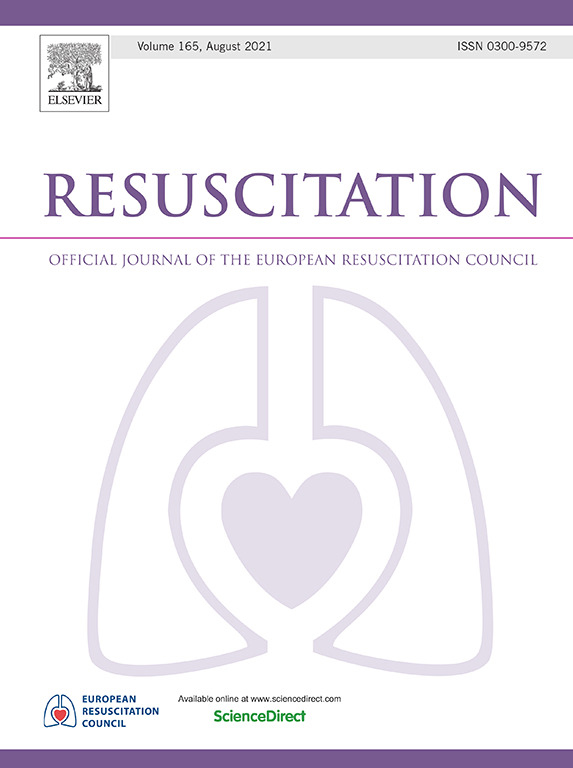心肌肌钙蛋白对院外心脏骤停后急性心肌梗死的诊断价值。
IF 4.6
1区 医学
Q1 CRITICAL CARE MEDICINE
引用次数: 0
摘要
背景:院外心脏骤停(OHCA)后,全身缺血可能导致心肌肌钙蛋白(cTn)升高和急性心肌梗死(AMI)的假阳性诊断。我们确定cTn对OHCA患者AMI的诊断价值。方法:纳入存活至出院的OHCA患者。评估医院记录,不知道cTn,以确定AMI的诊断。分析高敏感性肌钙蛋白T (hs-TnT)和肌钙蛋白I (TnI)。结果:618例患者中,179例(29%)诊断为st段抬高型心肌梗死(STEMI), 77例(13%)诊断为非st段抬高型心肌梗死(NSTEMI), 362例(59%)无AMI。STEMI与NSTEMI患者首hs-TnT差异有统计学意义(p=)。结论:cTn对OHCA患者AMI的诊断价值不足。使用cTn来确定OHCA的病因会导致AMI的过度诊断。本文章由计算机程序翻译,如有差异,请以英文原文为准。

Cardiac troponin for the diagnosis of acute myocardial infarction in patients after out-of-hospital cardiac arrest
Background
After out-of-hospital cardiac arrest (OHCA), global ischemia may cause cardiac troponin (cTn) elevation and false-positive diagnoses of acute myocardial infarction (AMI). We determined the diagnostic value of cTn to diagnose AMI in OHCA patients.
Methods
OHCA patients who survived to discharge were included. Hospital records were assessed, blinded to cTn, to determine the diagnosis AMI. High-sensitivity troponin T (hs-TnT) and troponin I (TnI) were analysed.
Results
Of 618 patients, ST-elevation MI (STEMI) was diagnosed in 179 patients (29 %), non-ST elevation MI (NSTEMI) in 77 patients (13 %) and 362 patients (59 %) had no AMI.
There was a significant difference in first hs-TnT between STEMI and NSTEMI patients (p ≤ 0.001) and between NSTEMI patients and patients without AMI (p = 0.013). To rule in any AMI (exceeding 4 × upper reference limit of normal (URL), specificity was 74 % (95 % CI 69–79) and positive predictive value 60 % (95 % CI 53–68). To rule out any AMI (not exceeding 1× URL), sensitivity was 95 % (95 % CI 92–98) and negative predictive value 83 % (95 % CI 72–94). AUC of the ROC curves of STEMI and NSTEMI, vs. no AMI were 0.772(95 % CI 0.721–0.824), 0.657(95 % CI 0.575–0.740) respectively and STEMI vs. NSTEMI 0.649(95 % CI 0.561–0.738). Number of shocks (p < 0.001) and time until return of spontaneous circulation (p < 0.001) were significantly correlated to peak hs-TnT in patients without AMI.
Conclusions
cTn has insufficient diagnostic value for AMI in OHCA patients. Use of cTn to establish the cause of OHCA results in overdiagnosis of AMI.
求助全文
通过发布文献求助,成功后即可免费获取论文全文。
去求助
来源期刊

Resuscitation
医学-急救医学
CiteScore
12.00
自引率
18.50%
发文量
556
审稿时长
21 days
期刊介绍:
Resuscitation is a monthly international and interdisciplinary medical journal. The papers published deal with the aetiology, pathophysiology and prevention of cardiac arrest, resuscitation training, clinical resuscitation, and experimental resuscitation research, although papers relating to animal studies will be published only if they are of exceptional interest and related directly to clinical cardiopulmonary resuscitation. Papers relating to trauma are published occasionally but the majority of these concern traumatic cardiac arrest.
 求助内容:
求助内容: 应助结果提醒方式:
应助结果提醒方式:


